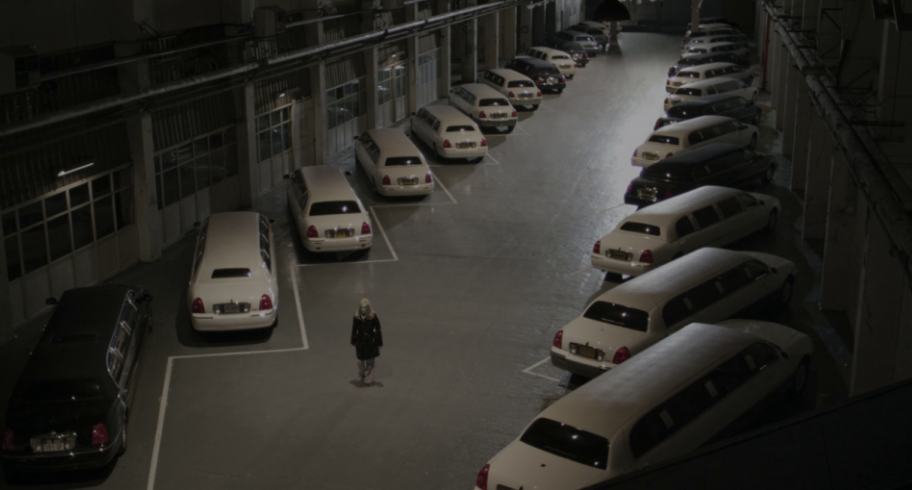Carax’s Holy Motors is an extremely interesting and unique film as it rejects the traditional narrative structure. In this film, Mr. Oscar plays many different roles. He changes appearances by dressing up in different costumes and alters his personality over the course of the film. The film is set in Paris, where Mr. Oscar dashes through the city due to his important job; however, it is difficult to understand exactly what that job is.
Mr. Oscar is driven around the city by Celine, who drives a white limousine. The limousine in this film is quite significant as it represents everything that happens behind the scenes. The limousine is practically Mr. Oscar’s dressing room, where he physically transforms his appearances and also where he adapts to the new role he is about to play in the real world. Oscar travels from appointment to appointment in this white limousine. At the end of the film, Celine drives the limousine to the garage, and the limousines begin talking to each other. Metaphorically, the limousine is what enabled Oscar to continue to transform throughout his life. It brought him from appointment to appointment, allowing him to change in between. Carax’s choice to present the limousines as living creatures who can talk to one another further highlights their importance in the film.

Additionally, mirrors play a significant role in the film. Oscar is constantly changing his appearance in order to adopt a different role, and the mirrors further symbolize that he is always examining himself and his identity. They also capture his transformation process. In the back of the limousine, he changes his costuming for each appointment, and the audience comprehends this by the use of mirrors. Usually actors transform themselves with the use of mirrors before performing; however, Oscar transforms himself with mirrors in the limousine in preparation for his next appointment. This emphasizes the ambiguity of the film and how it differs from the traditional cinematic nature.
Overall, the central theme in the film is appearances vs. reality. Carax stresses the idea that one can change their appearance to such an extent that it completely contradicts their reality. This film also urges the audience to self-reflect on their personal identity, and how one’s appearances play a role in identity formation. Ultimately, this film encourages the audience to explore the nature of identity.
Furthering your point on the use of symbols Jordyn, it is interesting to note how during the “false” costume changes, such as the one where “Feral Oscar” redoes the model’s clothes after kidnapping her, happen in the absence of such mirrors. Through mise-en-scene, judicial use of props has allowed us to track what level of reality are we to be believed to be following, and the absence of mirrors during the internal costume changes help us subconsciously track that we are still within the same appointment, despite the shift in scenery from the park to the sewer.
Regarding symbols, there is of course also the question of the roles of masks within the film. Many of the masks that are shown to us are fake, such as Feral Oscar’s excessively wrinkly skin, or the trenchcoat and wig donned by Oscar’s partner during the musical act. The only mask with no tether to reality is the one worn by Céline, as, post limosine-parking, says “I’m going home.” As seen in your screenshot, the mask she wears is a pale blue not meant to imitate any skin colour, a stark contrast to the masks worn by Oscar which are almost indistinguishable from his skin. Coupled with her meek and trepid walk out of the Holy Motors warehouse, these elements may combine to represent Céline as a contrast to Oscar in terms of her relationship to reality. Seeing the Holy Motors warehouse as a hostile place, she exclusively wears a mask in this movie to protect herself, for a functional purpose as opposed to an abstract form of art.
Even when she intervenes in the events, such as to save Oscar from his respective stabbing and shooting, she does not put on a costume, and she responds to Oscar’s advances in a realistic, grounded manner. Thus the symbolism of her mask is to display a different relationship to reality than the one put forward by Oscar and the actors, providing a sincere rooting in this highly abstract narrative.
I never thought about the importance of the limos throughout the movie, so thank you for bringing up this point. The limo is one of the most consistent things and settings of the film, and in the sense that you describe it in, it could be the only time we see the real Oscar. Outside of the limo, he is always portraying someone else’s identity, and there is no way of knowing who Oscar is, what his job is, or really anything about him. In his transitional phases of transforming between each of his appointments, are the only time he is not playing a role; he is himself. As often as that happens throughout the movie, there is still little to nothing for the audience to piece together who Oscar is. This shows the complexity of identities. How often do people switch their personalities in response to who they are interacting with? And which one of those personalities are the real “us?”